Ravenna
Ravenna
Ravèna, Ravêna ( Romagnol) | |
|---|---|
| Coordinates: 44°24′58″N 12°12′06″E / 44.41611°N 12.20167°E | |
| Country | Italy |
| Region | Emilia-Romagna |
| Province | Ravenna (RA) |
| Frazioni | (subdivisions)
|
| Government | |
| • Mayor | UTC+2 (CEST) |
| Postal code | 48100 |
| Dialing code | 0544 |
| Patron saint | Saint Apollinaris |
| Saint day | July 23 |
| Website | Official website |
| UNESCO World Heritage Site | |
|---|---|
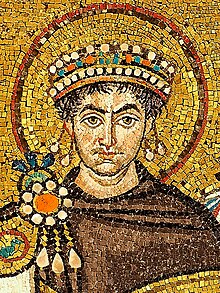 Mosaic of the Emperor Justinian I from the Basilica of San Vitale, Ravenna | |
| Criteria | Cultural: i, ii, iii, iv |
| Reference | 788 |
| Inscription | 1996 (20th Session) |
| Area | 1.32 ha |
Ravenna (
Initially settled by the Umbri people, Ravenna came under Roman Republic control in 89 BC. Octavian built the military harbor of Classis at Ravenna, and the city remained an important seaport on the Adriatic until the early Middle Ages. The city prospered under imperial rule. In 402, Western Roman emperor Honorius moved his court from Mediolanum to Ravenna; it then served as capital of the empire for most of the 5th century.
After the fall of the Western Roman Empire, Ravenna became the capital of Odoacer until he was defeated by the Ostrogoth king Theodoric. In 540 Belisarius conquered Ravenna for the Byzantine Empire, and the city became the capital of Byzantine Italy. After a brief Lombard control, Ravenna came under the authority of the Papacy and, save for minor interruptions, remained part of the Papal States until the mid-19th century when it was incorporated into the newly unified Kingdom of Italy.[5]
Although it is an inland city, Ravenna is connected to the Adriatic Sea by the Candiano Canal. It is known for its well-preserved late Roman and Byzantine architecture, with eight buildings comprising the UNESCO World Heritage Site "Early Christian Monuments of Ravenna".[6] Because of the high concentration of mosaics, the city has been associated with workshops and schools teaching mosaics, and is often given titles like the "capital of mosaics".[7][8][9]
History
The origin of the name Ravenna is unclear. Some have speculated that "Ravenna" is related to "Rasenna" (or "Rasna"), the term that the Etruscans used for themselves, but there is no agreement on this point.[10][11]
Ancient era
The origins of Ravenna are uncertain.
In 49 BC, it was where
Ravenna greatly prospered under Roman rule. Emperor
After many vicissitudes, Galla Placidia returned to Ravenna with her son, Emperor Valentinian III, due to the support of her nephew Theodosius II. Ravenna enjoyed a period of peace, during which time the Christian religion was favoured by the imperial court, and the city gained some of its most famous monuments, including the Orthodox Baptistry, the misnamed Mausoleum of Galla Placidia (she was not actually buried there), and San Giovanni Evangelista.
Ostrogothic Kingdom
The late 5th century saw the dissolution of Roman authority in the west, and

Both Odoacer and Theodoric and their followers were Arian Christians, but co-existed peacefully with the Latins, who were largely Catholic Orthodox. Ravenna's Orthodox bishops carried out notable building projects, of which the sole surviving one is the Cappella Arcivescovile. Theodoric allowed Roman citizens within his kingdom to be subject to Roman law and the Roman judicial system. The Goths, meanwhile, lived under their own laws and customs. In 519, when a mob had burned down the synagogues of Ravenna, Theodoric ordered the town to rebuild them at its own expense.
Theodoric died in 526 and was succeeded by his young grandson
From 540 to 600, Ravenna's bishops embarked upon a notable building program of churches in Ravenna and in and around the port city of Classe. Surviving monuments include the Basilica of San Vitale and the Basilica of Sant'Apollinare in Classe, as well as the partially surviving San Michele in Africisco.
Exarchate of Ravenna

Following the conquests of Belisarius for Eastern Roman Emperor Justinian I in the 6th century, Ravenna became the seat of the Byzantine governor of Italy, the Exarch, and was known as the Exarchate of Ravenna. It was at this time that the Ravenna Cosmography was written.[17]
Under Byzantine rule, the archbishop of the
Middle Ages and Renaissance
The
King
In 1198 Ravenna led a league of
Ravenna was ruled by Venice until 1509, when the area was invaded in the course of the Italian Wars. In 1512, during the Holy League wars, Ravenna was sacked by the French following the Battle of Ravenna. Ravenna was also known during the Renaissance as the birthplace of the Monster of Ravenna.
After the Venetian withdrawal, Ravenna was again ruled by legates of the Pope as part of the Papal States. The city was damaged in a tremendous flood in May 1636. Over the next 300 years, a network of
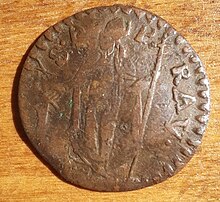
Modern age
Apart from another short occupation by Venice (1527–1529), Ravenna was part of the Papal States until 1796, when it was annexed to the French puppet state of the Cisalpine Republic (Italian Republic from 1802, and Kingdom of Italy from 1805). It was returned to the Papal States in 1814. Occupied by Piedmontese troops in 1859, Ravenna and the surrounding Romagna area became part of the new unified Kingdom of Italy in 1861.
During World War II, the town suffered severe damage. Fifty-two Allied bombing raids during the course of the Second World War had taken their toll, destroying some of Ravenna's noteworthy, unequalled early Christian art. Bombs intended for the railway station and its sidings had pulverised the Basilica of San Giovanni Evangelista in August 1944.[19] On 5 November 1944 troops of 4th Princess Louise Dragoon Guards, 5th Canadian Armoured Division and the British 27th Lancers entered and liberated Ravenna. A total of 937 Commonwealth soldiers who died in the winter of 1944–45 are buried in Ravenna War Cemetery, including 438 Canadians.[20]
Government
Major monuments
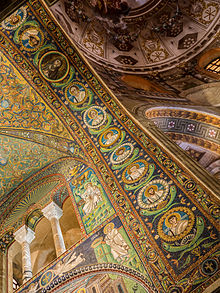


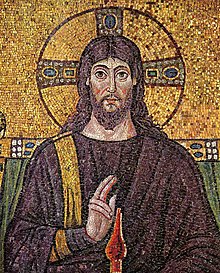
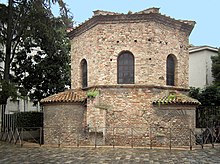


Eight early Christian buildings of Ravenna are inscribed on the
- Orthodox Baptistery also called Baptistery of Neon (c. 430)
- Mausoleum of Galla Placidia (c. 430)
- Arian Baptistery (c. 500)
- Archiepiscopal Chapel (c. 500)
- Basilica of Sant'Apollinare Nuovo (c. 500)
- Mausoleum of Theodoric (520)
- Basilica of San Vitale (548)
- Basilica of Sant'Apollinare in Classe (549)
Other historic sites include:
- The church of San Giovanni Evangelista is from the 5th century, erected by Galla Placidia after she survived a storm at sea. It was restored after the World War II bombings. The belltower contains four bells, the two majors dating back to 1208.
- The 6th-century church of the Spirito Santo, which has been quite drastically altered since the 6th century. It was originally the Arian cathedral. The façade has a 16th-century portico with five arcades.
- The Basilica of San Francesco, rebuilt in the 10th–11th centuries over a precedent edifice dedicated to the Apostles and later to St. Peter. Behind the humble brick façade, it has a nave and two aisles. Fragments of mosaics from the first church are visible on the floor, which is usually covered by water after heavy rains (together with the crypt). Here the funeral ceremony of Dante Alighieri was held in 1321. The poet is buried in a tomb annexed to the church, the local authorities having resisted for centuries all demands by Florence for the return of the remains of its most famous exile.
- The Baroque church of Santa Maria Maggiore (525–532, rebuilt in 1671). It houses a picture by Luca Longhi.
- The church of San Giovanni Battista (1683), also in Baroque style, with a Middle Ages campanile.
- The basilica of Santa Maria in Porto (16th century), with a rich façade from the 18th century. It has a nave and two aisles, with a high cupola. It houses the image of famous Greek Madonna, which was allegedly brought to Ravenna from Constantinople.
- The nearby Communal Gallery has various works from Romagnoli painters.
- The Rocca Brancaleone (Brancaleone Castle), built by the Venetians in 1457. Once part of the city walls, it is now a public park. It is divided into two parts: the true Castle and the Citadel, the latter having an extent of 14,000 m2 (150,694.75 sq ft).
- The "so-called Palace of Theodoric", in fact the entrance to the former church of San Salvatore. It includes mosaics from the true palaceof the Ostrogoth king.
- The church of Sant'Eufemia (18th century), gives access to the so-called Stone Carpets Domus (6th–7th century): this houses splendid mosaics from a Byzantine palace.
- The National Museum
- The Archiepiscopal Museum
- The hunting cabin on the road to Porto Corsini known for having sheltered Giuseppe Garibaldi on the night of 6–7 August 1849[21][22]
Music
The city annually hosts the Ravenna Festival, one of Italy's prominent classical music gatherings. Opera performances are held at the Teatro Alighieri while concerts take place at the Palazzo Mauro de André as well as in the ancient Basilica of San Vitale and Basilica of Sant'Apollinare in Classe. Chicago Symphony Orchestra music director Riccardo Muti, a longtime resident of the city, regularly participates in the festival, which invites orchestras and other performers from around the world.
In literature
- After his banishment from his native Florence, Dante spent most of the rest of his life in Ravenna, and he mentions the city in Canto V of his Inferno.
- Also in the 16th century, Nostradamus provides four prophecies:
- "The Magnavacca (canal) at Ravenna in great trouble, Canals by fifteen shut up at Fornase", in reference to fifteen French saboteurs.[23]
- As the place of a battle extending to Perugia and a sacred escape in its aftermath, leaving rotting horses left to eat.
- In relation to the snatching of a lady "near Ravenna" and then the legate of Lisbon seizing 70 souls at sea.
- Ravenna is one of three-similarly named contenders for the birth of the third and final Antichrist who enslaves Slovenia (see Ravne na Koroškem).[24]
- Ravenna is the setting for The Witch, a play by Thomas Middleton.
- Lord Byron lived in Ravenna between 1819 and 1821, led by the love for a local aristocratic and married young woman, Teresa Guiccioli. Here he continued Don Juan and wrote Ravenna Diary, My Dictionary and Recollections.[25]
- Ravenna is the location where Lionel, the protagonist of Mary Shelley's post-apocalyptic novel The Last Man, comes ashore after losing his companions to a howling storm in the Aegean Sea.
- Oscar Wilde (1854–1900) wrote a poem Ravenna in 1878.[26]
- Symbolist, lyrical poet Alexander Blok (1880–1921) wrote a poem entitled Ravenna (May–June 1909) inspired by his Italian journey (spring 1909).
- During his travels, German poet and philosopher Hermann Hesse (1877–1962) came across Ravenna and was inspired to write two poems of the city. They are entitled Ravenna (1) and Ravenna (2).
- T. S. Eliot's (1888–1965) poem "Lune de Miel" (written in French) describes a honeymooning couple from Indiana sleeping not far from the ancient Basilica of Sant'Apollinare in Classe (just outside Ravenna), famous for the carved capitals of its columns, which depict acanthus leaves buffeted by the wind, unlike the leaves in repose on similar columns elsewhere.
- J.R.R. Tolkien (1892–1973) may have based his city of Minas Tirith at least in part on Ravenna.[27]
In film
Michelangelo Antonioni filmed his 1964 movie Red Desert (Deserto Rosso) within the industrialised areas of the Pialassa valley.
Transport
Ravenna has an important commercial and tourist port.
Ravenna railway station has direct Trenitalia service to Bologna, Ferrara, Lecce, Milan, Parma, Rimini, and Verona.
Freeways crossing Ravenna include: A14-bis from the hub of Bologna; on the north–south axis of EU routes E45 (from Rome) and E55 (SS-309 "Romea" from Venice); and on the regional Ferrara-Rimini axis of SS-16 (partially called "Adriatica").
Amusement parks
Twin towns – sister cities
 Chichester, United Kingdom, since 1996
Chichester, United Kingdom, since 1996 Speyer, Germany, since 1989
Speyer, Germany, since 1989 Chartres, France, since 1957
Chartres, France, since 1957
Sports
The traditional
The beaches of Ravenna hosted the 2011 FIFA Beach Soccer World Cup, in September 2011.
People
- Valentinian III (419–455), Roman Emperor
- Matteo Plazzi, Italian sailor
- Giacomo Anziani (1681–1723), Italian architect, painter, and engraver
- Laura Pausini (born 1974), Italian pop singer-songwriter, record producer and television personality
- Raul Gardini (1933–1993), Italian businessman
- Franco Manzecchi (1931–1979), Jazz drummer
- Andrea Montanari (born 1965), Italian sprinter
- Arcangelo Corelli (1653–1713), Baroque violinist and composer
- Luigi Legnani (1790–1877), guitarist and luthier
- Tullio Bassi (born 1937), Italian violin maker
- Peter Damian (c. 988 – 1072 or 1073), Catholic Saint and Cardinal
- Francesco Ingoli (1578–1649), Theatine scientist, lawyer, and disputer of Galileo
- Francesca da Rimini (1255 – c. 1285), historical person
- Guido I da Polenta (died 1310), lord of Ravenna
- Francesco Baracca (1888–1918), Italy's top fighter ace of World War I
- Federico Caricasulo (born 1996), motorcycle road racer
- Marco Melandri (born 1982), motorcycle road racer
- Davide Tardozzi (born 1959), Superbike racer and team manager
- Ivano Marescotti (1946–2023), actor
- Amadeus (presenter) (born 1962), presenter
- Romolo Gessi (1831–1881), explorer
- Romuald (c. 951 – c. 1025/27), abbot, founder of the Camaldolese order
- Marco Dente (1493–1527), engraver
- Paolo Roversi (born 1947), fashion photographer
- Angelo Mariani (conductor) (1821–1873), conductor
- Giuseppe Vitali (1875–1932), mathematician
- Evangelista Torricelli (1606–1647), physicist and mathematician
- Federico Marchetti (businessman) (born 1969), founder of YOOX
- Gianluca Costantini (born 1971), artist
- Luigi Legnani (1790–1877), musician and composer
- Luigi Rossini (1790–1857), artist
- Alex Majoli (born 1971), photographer
- Gianluca de Lorenzi (born 1972), racing driver and team owner
- Fabio Fabiani (born 1974), racing driver
- Eugenio Pisani (born 1991), racing driver
See also
References
- ^ "Superficie di Comuni Province e Regioni italiane al 9 ottobre 2011". Italian National Institute of Statistics. Retrieved 16 March 2019.
- ^ GeoDemo - Istat.it
- Ravenna grass, the Ravennate fleet—while "Ravennese" is more common in reference to people. The neologism "Ravennan" is also encountered. The Italian form is ravennate; in Latin, Ravennatus, Ravennatis, and Ravennatensis are all encountered.
- ^ "Storia dell'Esarcato d'Italia". www.homolaicus.com. Retrieved 2024-01-05.
- ^ a b c "Ravenna - Treccani". Treccani (in Italian). Retrieved 2024-01-05.
- ^ "Early Christian Monuments of Ravenna".
- ^ "Day Trip to Ravenna: What to See in Italy's Mosaic Capital". ITALY Magazine. Retrieved 2023-05-18.
- ^ Franceschini |, Giulia (2023-04-24). "Ravenna, the capital of Italian mosaic". L'Italo-Americano – Italian American bilingual news source. Retrieved 2023-05-18.
- S2CID 225764842.
- ^ Names, All Things Baby (2019-05-31). "Ravenna Name Meaning, Origin, Popularity, and More". All Things Baby Names. Retrieved 2023-01-11.
- ^ Tourism in Ravenna – Official site – History. Turismo.ravenna.it (2010-06-20). Retrieved on 2011-06-20.
- ^ Deborah M. Deliyannis, Ravenna in Late Antiquity (Cambridge University Press, 2010), for this and much of the information that follows
- ^ Mascanzoni, Leardo (1990). Ravenna: Una storia millenaria (in Italian). Giunti Barbera Editore. pp. 3–50.
- ^ From the Latin for "fleet".
- ^ Dio 72.11.4-5; Birley, Marcus Aurelius
- ^ Fischer, Svante; Victor, Helena. "The Fall and Decline of the Roman Urban Mind". Academia.
- ^ "Storia di Ravenna. Dalla preistoria all'anno Duemila". ilpontevecchio (in Italian). Retrieved 2024-01-05.
- ISBN 0-8122-1239-8.
- ^ "The riches of Ravenna". 10 December 2020.
- ^ "Canada - Italy 1943-1945 - the Second World War - History - Remembrance - Veterans Affairs Canada". 23 June 2021.
- ^ "La storia del capanno Garibaldi, in vetrina al Private Banking foto d'epoca e dipinti" [The history of the Garibaldi hut on display at Private Banking: Vintage photos and paintings]. Il Resto del Carlino (in Italian). 21 May 2022. Retrieved 4 April 2024.
- ^ "Al "Private Banking" de La Cassa di Ravenna una nuova mostra dedicata al Capanno Garibaldi" [At the “Private Banking” of La Cassa di Ravenna, a new exhibition dedicated to the Capanno Garibaldi]. ravennanotizie.it (in Italian). 20 May 2022. Retrieved 4 April 2024.
- ISBN 978-1-4349-1823-9.
- ISBN 978-1-906787-39-4.
- ^ "Sito Ufficiale – Ufficio Turismo del Comune di Ravenna – I grandi scrittori". Turismo.ra.it. Retrieved 2009-05-06.
- ^ Ravenna
- TheGuardian.com. 23 October 2015.
- ^ "Città gemellate". comune.ra.it (in Italian). Ravenna. Retrieved 2021-03-28.
Sources
- Cameron, Averil. "Ravenna: Capital of Empire, Crucible of Europe". History Today (September 2020) pp 94–97.
- Janet Nelson, Judith Herrin, Ravenna: its role in earlier medieval change and exchange, London, Institute of Historical Research, 2016, ISBN 978-1-909646-14-8
External links
- Ravenna - Catholic encyclopedia
- Tourism and culture Official website (in Italian and English)
- Ravenna, A Study (1913) by Edward Hutton, from Project Gutenberg
- Ravenna's early history and its monuments - Catholic Encyclopedia













